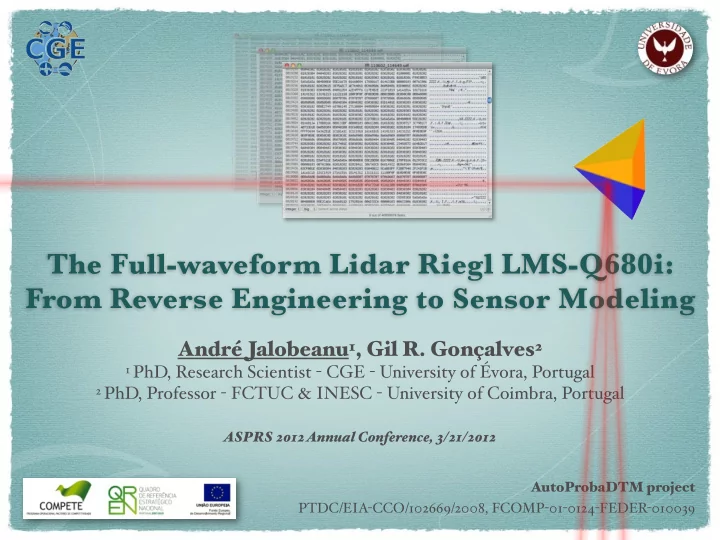

The Full-waveform Lidar Riegl LMS-Q680i: From Reverse Engineering to Sensor Modeling André Jalobeanu 1 , Gil R. Gonçalves 2 1 PhD, Research Scientist - CGE - University of Évora, Portugal 2 PhD, Professor - FCTUC & INESC - University of Coimbra, Portugal ASPRS 2012 Annual Conference, 3/21/2012 AutoProbaDTM project PTDC/EIA - CCO/102669/2008, FCOMP - 01 - 0124 - FEDER - 010039
Outline Project objectives Why do we need raw data? Decoding the information Format description Modeling the instrument Waveform processing Study area & first results USGS Perspectives
Project scientific objectives AutoProbaDTM (3-year project, FCT Portugal) Auto mated Proba bilistic D igital T errain M odel generation from raw airborne LiDAR data Generate gridded elevation models Robustly estimate the bare ground topography Lower the acquisition costs by extending the range through processing Provide consistent, predictive spatial accuracy maps rather than classical uniform error measures using control points Minimize the user interaction: automatic parameter estimation Process large datasets >1G waveforms Bonus: extract canopy height and vegetation parameters ... but first read and understand the raw data!
Towards a probabilistic raster DEM raw LiDAR data POS file: waveforms y ( t ) timestamps, θ trajectory, attitude Wave Georef Grid range, σ range , Z, σ Z X, Y waveform direct joint processing georeferencing gridding & filtering DEM + error map internal parameters Raster: z, σ z Calibrate Analyze boresight alignment DEM - derived products
Principles of airborne LiDAR what do we need? timestamps look angles waveforms Riegl 2. Scanning: 1. Time of flight measurement aircraft motion + laser rotation ( waveform acquisition ) 3. Direct georeferencing IMU: GPS+INS
Decoding the Riegl LMS-Q680i binary file format The proprietary software RiAnalyze from Riegl can display a wave and some related information, and provides the processing results as a text file ( timestamp, range, theta, etc. ) ➔ Reverse engineering 6 GB binary files ( .sdf ) + processing byproducts, e.g. sdh text files ( header constants ) Update: RiW aveLib first released in 07/2011, but sti lm has issues and limitations... such as radiometric modeling!
The sdf file general structure Header Sync Rec Ctrl Pulse Pulse Pulse ... 1st row record record record Control record (GPS sync) Control record Pulse Pulse Pulse ... 2nd row Data Data Data Sync record record record chk Rec EmPulse RecWave ... RecWave Hdr Hdr Hdr Control Pulse record (timing, orientation, waveform) record other ... rows General file structure data timestamp angle record angle number data emitted encoder timestamp encoder of blocks length pulse Record structure 00 22 00 1C 83 B8 C8 D6 01 66 01 05 09 25 01 67 01 56 25 59 1F FF FE 02 00 6B C0 06 02 02 02 02 02 07 14 3B 78 B1 C8 AE 76 3F 1C 0B 05 03 03 05 05 03 00 00 02 73 00 14 03 02 02 02 02 03 03 04 02 03 03 04 08 10 1A 1F 1C 13 0A 06 02 02 01 02 02 04 03 03 03 02 02 03 02 02 02 03 01 02 01 01 ( big endian ) 02 03 02 03 03 02 02 02 03 03 02 03 02 02 02 03 02 02 02 03 03 03 03 02 02 02 02 01 02 03 02 02 02 01 03 03 03 03 02 02 A8 BB AD 82 received waves checksum
Recommend
More recommend